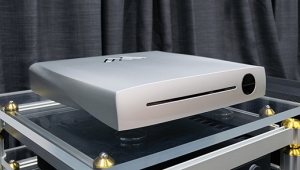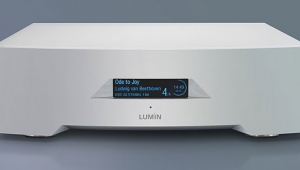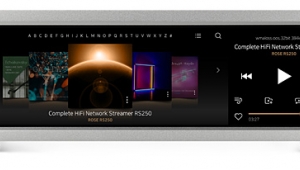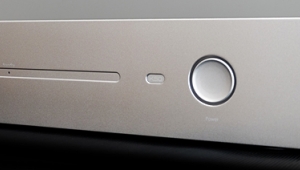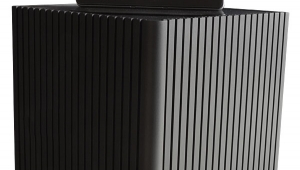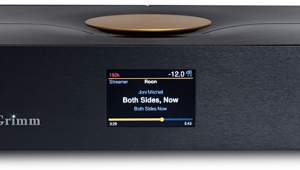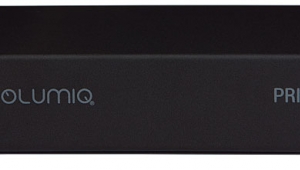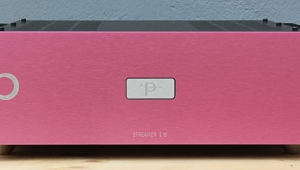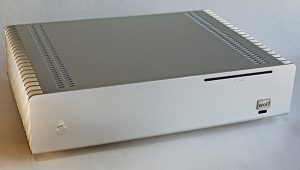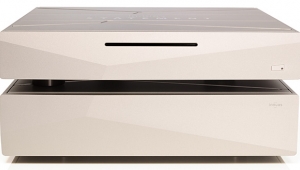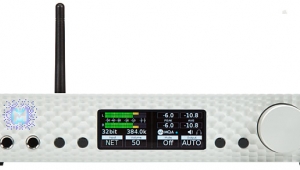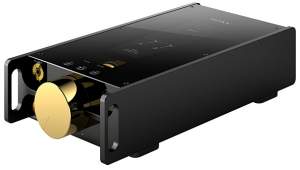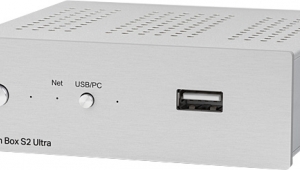| Columns Retired Columns & Blogs |
Apple iPod portable music player Page 3
What a thing to do!
The iPod is different from CD players, SACD players, DVD-Audio players, and pretty much any other consumer audio player in that it is a data-storage device. At the moment, it offers a variety of data-storage formats; but while I'm aware of no plans to do so, in the future it could accommodate others—even higher-rez options.
The iPod is different from CD players, SACD players, DVD-Audio players, and pretty much any other consumer audio player in that it is a data-storage device. At the moment, it offers a variety of data-storage formats; but while I'm aware of no plans to do so, in the future it could accommodate others—even higher-rez options.
The formats the iPod accommodates at the moment offer a wide range of options that balance disc storage space against sound quality. And this, not the iPod's size, is the revolutionary part: the consumer gets to choose which set of tradeoffs suits his or her needs.
This rather basic insight completely escaped me at first. I ripped the same piece of music (Carla Bley's "Looking for America," from the CD of the same title, WATT/31) in a panoply of formats to get to the bottom of the audiophilic question of which sounded best. While performing the comparisons, it gradually sank in that the iPod allowed its user to set the sound bar as high or as low as the situation required. But that wasn't the true brainstorm. No, that would be my realization that there might, in fact, be no single answer to the question, even for sonically picky listeners such as myself. It all depended on how I intended to use the iPod.
Even though the new iPod maxes out at 30GB, it's probably best not to think of it as the permanent repository of your entire music collection. That's what iTunes4 and your computer are for. With FireWire's high-speed data transfer, it's a matter of a few minutes and a few keystrokes to pack the iPod with situation-specific playlists. Going out for a long jog? Download a few hours of music ripped at 192kbps on MP3 or AAC. It'll serve. Listening attentively through your big rig? Download a program ripped in AIFF—it'll match the original for sound quality.
Of course, this means you may have to rip many songs, albums, or programs twice, which can gobble up masses of hard-drive space—but you can buy 120GB FireWire HDDs for a couple of hundred bucks these days. Jim Thiel likes to observe that "watts is cheap." These days, so is gigabytes.
What do you want to be?
The iPod offers such an embarrassment of choices regarding file storage and playback that I had to begin by discarding quite a few of them as irrelevant to a discussion of its fidelity. That's not to say that 96kbps MP3 and AAC, for example, aren't useful space-saving options; simply that they represent sonic compromises most readers of this magazine wouldn't tolerate even while jogging. For the purposes of the following comparisons, I ran the line-out from the docking cradle (thus bypassing the iPod's volume control) to a Musical Fidelity Tri-Vista 300 integrated amplifier, which drove a pair of Amphion Xenon floorstanding loudspeakers. I used Shunyata Research Lyra speaker cables and a Kimber Kable stereo mini-to-RCA interconnect.
Things are somewhat better at 128kbps in both MP3 and AAC, but neither cuts the mustard for critical listening at home. MP3 robbed Steve Swallow's pulsing bass lines of dynamics and punch on the Carla Bley album, while blunting the shimmer of the brass overtones. AAC fared slightly better, offering better bass response (although it was still pretty lightweight compared to the original CD) and slightly more extended HF (again, shelved down in comparison to the CD).
Surprisingly, upping the bit rate to 160kbps did not result in major improvements for either format. Bass impact remained MIA in MP3, and the upper frequencies sounded strident, with that unmistakable "too much compression" punchiness. AAC again sounded marginally better, although Bley's big band still seemed flattened and lacking in dynamic variation.
The audiophile in me began to pay attention at 192kbps. Both MP3 and AAC began to exhibit a small degree of soundstaging, albeit not with great amounts of front-to-back dimensionality or layering. MP3's highs began to lose their stridence, and AAC sounded fairly detailed and revealing.
The compressed formats began to show some real promise at 320kbps. Definition, detail, and soundstaging were all impressive, and high-frequency response was almost liquid in its lack of edge effects. At this rate, differences between the two formats jumped into sharper focus: MP3 made transients "splashy," while AAC just sounded anemic compared to the original. With both formats, dynamic variation was considerably reduced compared to the CD.
Best of all—and, to my ears, completely indistinguishable from the original CD—was AIFF. Dynamics were impressive, imaging was nuanced and detailed, and the frequency extremes sounded extended and natural. On my reference rig, I could listen with immense pleasure for hours on end to files ripped in AIFF. In fact, I did.
Ah, some of you are saying, but what about VBR? Variable bit-rate formats seem to offer extremely satisfying sound and show a great deal of potential, but those options deserve greater exploration in a dedicated comparison.
How does it feel to be
One of the beautiful people?
Apple's 30GB iPod is an extremely sexy gadget. As a piece of industrial design, it is remarkable in its beauty and operability. As an extension of Apple's lifestyle-friendly suite of music-photography-video applications, it is a screaming success. It's fun to use, and if just seeing one is enough to induce lust, actually holding one is enough to tempt a righteous man to larceny. But is it a serious piece of kit worthy of serious consideration by an audiophile?
Surprisingly enough, I believe the answer is yes. The open nature of the iPod's playback format—or, more properly speaking, its lack of a single playback standard—means that the player can offer the sound quality its owner demands of it. Presumably, that could even include options not currently supported, including space-hogging, hi-rez digital files. However, that will happen only if audiophiles take hard-drive-based players seriously enough to participate in the ongoing dialog concerning their use and possibilities.
Fortunately, that's already happening, as a quick Google of the subject will reveal. Users are actively seeking better sound, even as they trade stories about how much fun they're having with the product as it currently exists.
And why shouldn't they be happy? With the iPod, you can have your cake and eat it, too. On the outside, all that the rest of the world will see is that you're one of the iPod-totin' beautiful people; no one will ever know that under those headphones you're listening to monstrously good-sounding, hi-rez digital copies of your favorite demo discs. Baby, you're a rich man!
- Log in or register to post comments
